Our "20 Year Project". We're looking forward to building our brand new garden, year by year, from almost scratch. Apart from a few very small trees, our newly acquired tract is currently only a bare stretch of grass. So starting July 23rd, 2007 when we take possession it's "on with the show" ..... and please come back often and watch us grow!
Greetings from the Niagara!

Enjoying a hike on the Bruce Trail near our home.
Contact Us
marandmike
AT
sympatico
DOT
ca
AT
sympatico
DOT
ca
Welcome to All Green Thumbs!

This is Marilyn & Mike

This is Definitely Mike!

What's a Garden Without Our Best Friends!
| Gardening Definition of the Day |
| Put Gardening Definition of The Day on Your Site for Free |
Handy Gardeners' Plant Database Search Engine
Handy Image Search Engine
Example: Type in "rhododendron" and see the exquisite results! Have fun with virtually any image search!
Gnome Sweet Gnome

Hardiness Zone Colour Legend

Hardiness Zone Map ~ Great Lakes

Hardiness Zone Map ~ USA

Wish List
- Clematis
- Herb Patch
- Red Trillium
- Win a lottery!
New Word Coined by Gardening Author
"Hortgasm" - A hortgasm is what a garden fanatic has when sighting a particularly beautiful specimen. ~ James Dodson, Beautiful Madness, Penguin Group, 2007
Great Source for Japanese Maples and Bonsai
Alan Trafford
* Tel (905) 309-1697
* E-mail atrafford@hotmail.com
* Also maintains stall every Sunday at Jordan Market, Jordon, Ontario
* Tel (905) 309-1697
* E-mail atrafford@hotmail.com
* Also maintains stall every Sunday at Jordan Market, Jordon, Ontario
Great Source for Perennials!!!!
Cindy Ripley
6 Nursey Lane (No Kidding!)
Fonthill
905-892-5598
cindyripley@hotmail.com
Best call or E-mail for an appointment
We bought 45 plants for $30 on July 10/07.
That has to be the best price anywhere!
She has them growing in her garden, plus has pictures of all, so great way to choose your own.
HIGHLY RECOMMENDED!

6 Nursey Lane (No Kidding!)
Fonthill
905-892-5598
cindyripley@hotmail.com
Best call or E-mail for an appointment
We bought 45 plants for $30 on July 10/07.
That has to be the best price anywhere!
She has them growing in her garden, plus has pictures of all, so great way to choose your own.
HIGHLY RECOMMENDED!
Botanical Gardens
Gardening Blogs We Enjoy Reading and Learning From
- A Bumblebee Garden
- An Eclectic Garden
- An Iowa Garden
- Bliss
- Chitweed
- Gardening for Health
- Girl Gone Gardening
- GuppyStorm's Garden
- Kerry's Garden
- Life in the Highlands
- Morning Glories
- Mr. Brown Thumb
- My Grandpa's Garden
- Rhododendron Society of Canada, Niagara Region
- Rosemarie's Garden
- Sweet Home and Garden Chicago
- Takoma Gardener
- The Balcony Garden
- The Gorham Garden
- Through the Hedge
- Top 100 Gardening Sites
Blog Archive
-
▼
2009
(21)
-
▼
July
(8)
- ... from our E-mailbag ~ from Adelaide, Australia ...
- Our Hollyhocks are Blooming!
- Measuring the Jefferies
- Gardening Time Out`
- July 4th, 2009 ~ The Rosemary is in Beautiful Bloo...
- Tonight in the Upper Garden at Sunset ~ July 3rd, ...
- Images in Our Garden at Sunrise Today ... July 2nd...
- Happy Canada Day! Images from Around Our Garden on...
-
▼
July
(8)
Are You a Visiting Gardener? Please Sign and Comment on Our Guestmap!
~ Visitor Count ~ Thanks So Much for Dropping In! Come Again! And Again!
Bee Balm

Monarda (bee balm, horsemint, oswego tea, or bergamot) is a genus consisting of roughly 16 species of erect, herbaceous annual or perennial plants in the Lamiaceae, indigenous to North America. Ranging in height from 1 to 3 feet (0.2 to 0.9 m), the plants have an equal spread, with slender and long-tapering (lanceolate) leaves; the leaves are opposite on stem, smooth to nearly hairy, lightly serrated margins, and range from 3 to 6 inches (7 to 14 cm) long. In all species, the leaves, when crushed, exude a spicy, highly fragrant oil.
Cleome

Cleome is a genus of flowering plants traditionally included in the family Capparaceae. Some recent classifications (e.g. the APG II system have included the Capparaceae within Brassicaceae, while others classifications have transferred Cleome (along with other related genera) to its own family Cleomaceae, separate from both Capparaceae and Brassicaceae.
Candy Lily

Pardancanda norrisii, candy lily. 36". Candy lilies are hybrids between Belamcanda chinensis and Pardanthopsis dichotoma. They are very similar to Belamcanda but with larger flowers in a wider range of colors from blue and purples through yellows, reds, oranges, and bi-colors, with or without dark spots on the petals. Individual blooms last for one day but keep coming for weeks. They have iris like foliage and are often mistaken for iris, especially when they first emerge. Plant Pardancanda in average to rich, well-drained soil in full sun to part shade. Plants divide easily in spring or late summer. Plants often self sow, but the seedlings are easily transplanted or weeded out. If fungul or bacterial leaf spot become a problem, trim off affected foliage and move plants to a location with more sun, better drainage, and better air circulation.
Chinese Lantern
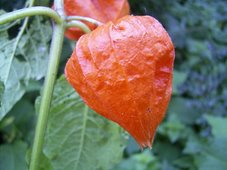
Physalis alkekengi (Bladder-cherry, Chinese Lantern, Japanese-lantern, or Winter cherry; Japanese: hozuki), is a relative of P. peruviana (Cape Gooseberry), easily identifiable by the larger, bright orange to red papery covering over its fruit, which resemble Chinese lanterns. It is native from southern Europe east across southern Asia to Japan. It is a popular ornamental plant, though can be invasive with its wide-spreading root system sending up new shoots some distance from where it was originally planted.
Columbine
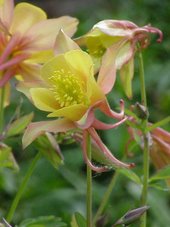
Aquilegia caerulea is a species of Aquilegia native to the Rocky Mountains from Montana south to New Mexico and west to Idaho and Arizona. Common names include Colorado Blue Columbine and Rocky Mountain Columbine, the latter also shared with Aquilegia saximontana. It is a herbaceous perennial plant growing to 20-60 cm tall. The flowers are very variable in color, from pale blue (as in the species name caerulea) to white, pale yellow and pinkish; very commonly the flowers are bicolored, with the sepals a different shade to the petals. Aquilegia caerulea is the state flower of Colorado. It is also a popular ornamental plant in gardens, with numerous cultivars selected for different flower colors. There are five varieties: Aquilegia caerulea var. alpina, Aquilegia caerulea var. caerulea, Aquilegia caerulea var. daileyae, Aquilegia caerulea var. ochroleuca, and Aquilegia caerulea var. pinetorum.
Cornflower

The Cornflower (Centaurea cyanus) also known as Bachelor's button, Basket flower, and Boutonniere flower is a small annual flowering plant in the family Asteraceae, native to Europe. It is an annual plant growing to 40-90 cm tall, with grey-green branched stems. The leaves are lanceolate, 1-4 cm long. The flowers are most commonly an intense blue colour, produced in flowerheads (capitula) 1.5-3 cm diameter, with a ring of a few large, spreading ray florets surrounding a central cluster of disc florets. The blue pigment is protocyanin, which in roses is red. In the past it often grew as a weed in crop fields. It is now endangered in its native habitat by agricultural intensification, particularly over-use of herbicides, destroying its habitat; in the United Kingdom it has declined from 264 sites to just 3 sites in the last 50 years. It is also however, through introduction as an ornamental plant in gardens and a seed contaminant in crop seeds, now naturalised in many other parts of the world, including North America and parts of Australia. It is grown as an ornamental plant in gardens, where several cultivars have been selected with varying pastel colours, including pink and purple. It is also occasionally used as a culinary ornament. Cornflowers have been used and prized historically for its blue pigment. Cornflowers are often used as an ingredient in tea and is famous in the Lady Grey blend of Twinings. In folklore, cornflowers were worn by young men in love; if the flower faded too quickly, it was taken as a sign that the man's love was unrequited. In herbalism a decoction of cornflower is effective in treating conjunctivitis, and as a wash for tired eyes. The Blue Cornflower has been the national flower of Estonia since 1968 and symbolizes daily bread to Estonians. It is also the symbol of the Estonian political party, Rahvaliit, the Finnish political party, National Coalition Party, and the Swedish political party, Liberal People's Party. The Cornflower is also often seen as an inspiration for the romantic symbol of the Blue Flower. The Blue Cornflower was the favourite flower of Kaiser Wilhelm I. Because of its ties to royalty, authors such as Theodor Fontane have used it, often sarcastically, to comment the social and political climate of the time. In Austria it is a political symbol for pan-German and rightist ideas. The Members of the Freedom Party wore it at 2005's Parliament Opening. The Cornflower is the national flower of Poland.
Delphinium

Delphinium is a genus of about 250 species of annual, biennial or perennial flowering plants in the buttercup family Ranunculaceae, native throughout the Northern Hemisphere and also on the high mountains of tropical Africa. The common name, shared with the closely related genus Consolida, is Larkspur. The leaves are deeply lobed with 3-7 toothed, pointed lobes. The main flowering stem is erect, and varies greatly in size between the species, from 10 cm in some alpine species, up to 2 m tall in the larger meadowland species; it is topped by many flowers, varying between purple, blue, red, yellow or white. The flower has five petals which grow together to form a hollow flower with a spur at the end, which gives the plant its name. The seeds are small and shiny black. The plants flower from late spring to late summer, and are pollinated by butterflies and bumble bees. Despite the toxicity, Delphinium species are used as food plants by the larvae of some Lepidoptera species including Dot Moth and Small Angle Shades. Other names are, lark's heel (Shakespeare), lark's claw and knight's spur. The scientific name is taken from Dioscorides and describes the shape of the bud, which is thought to look like a (rather fat) dolphin. The Forking Larkspur (Delphinium consolida) prefers chalky loams. It grows wild in cornfields, but has become very rare nowadays. The flowers are commonly purple, but a white variety exists as well. Baker's larkspur (Delphinium bakeri) and Yellow larkspur (D. luteum), both native to very restricted areas of California, are highly endangered species. Many species are cultivated as garden plants, with numerous cultivars having been selected for their denser, more prominent flowers. All parts of the plant contain an alkaloid delphinine and are very poisonous, causing vomiting when eaten, and death in larger amounts. In small amounts, extracts of the plant have been used in herbal medicine. Gerard's herball reports that drinking the seed of larkspur was thought to help against the stings of scorpions, and that other poisonous animals could not move when covered by the herb, but does not believe it himself. Grieve's herbal reports that the seeds can be used against parasites, especially lice and their nits in the hair. A tincture is used against asthma and dropsy. The juice of the flowers, mixed with alum, gives a blue ink. The plant was connected to Saint Odile and in popular medicine used against eye-diseases. It was one of the herbs used on the feast of St. John and as such warded against lightning. In Transylvania, it was used to keep witches from the stables, probably because of its blue color. Larkspur, especially tall larkspur, is a significant cause of cattle poisoning on rangelands in the western United States. Larkspur is more common in high-elevation areas, and many ranchers will delay moving cattle onto such ranges until late summer when the toxicity of the plants is reduced.
Dianthus

Dianthus is a genus of about 300 species of flowering plants in the family Caryophyllaceae, native mainly to Europe and Asia, with a few species extending south to north Africa, and one species (D. repens) in arctic North America. Common names include carnation (D. caryophyllus), pink (D. plumarius and related species) and sweet william (D. barbatus). The name Dianthus is from the Greek words dios ("god") and anthos ("flower"), and was cited by the Greek botanist Theophrastus. The species are mostly perennial herbs, a few are annual or biennial, and some are low subshrubs with woody basal stems. The leaves are opposite, simple, mostly linear and often strongly glaucous grey-green to blue-green. The flowers have five petals, typically with a frilled margin, and are (in almost all species) pale to dark pink. One species (D. knappii) has yellow flowers with a purple centre. Dianthus species are used as food plants by the larvae of some Lepidoptera species including Cabbage Moth, Double-striped Pug, Large Yellow Underwing and The Lychnis. Also three species of Coleophora case-bearers feed exclusively on Dianthus: C. dianthi, C. dianthivora and C. musculella (which feeds exclusively on D. suberbus). The colour pink may be named after the flower. The origin of the flower name 'pink' is unknown; it has been suggested that it comes from the frilled edge of the flowers, which look as though they were cut with pinking shears, but actually, the shears were patented in 1893 and got their name from the flower.
False Dragonhead

Physostegia virginiana is more commonly known as Obedience Plant or False Dragonhead, since when bent, the stems will take the new shape. Obedience Plant can grow up to 4 feet tall. Small white flowers bloom on the plant in July and August. It will spread by rhizomes, and can spread at a very fast rate. The flowers are usually white, though light pink flowers are also possible. It is a perennial that is native to most of the United States, except for the Pacific Coast states.
Foxglove

Digitalis is a genus of about 20 species of herbaceous perennials, shrubs and biennials that was traditionally placed in the figwort family Scrophulariaceae. Due to new genetic research, it has now been placed in the much enlarged family Plantaginaceae. The genus is native to Europe, western and central Asia and northwestern Africa. The term digitalis is also used for preparations containing cardiac glycosides, particularly digoxin, extracted from plants of this genus. The members of this genus are known in English as foxgloves. The scientific name means "finger-like", and refers to the ease with which a flower of Digitalis purpurea can be fitted over a human fingertip. The flowers are produced on a tall spike, are tubular, and vary in colour with species, from purple to pink, white and yellow. The best-known species is the Common Foxglove, Digitalis purpurea. It is a biennial, often grown as an ornamental plant due to its showy flowers, that range in colour from purples through to whites, with variable marks and spotting. The first year of growth produces only the long, basal leaves, while in the second year the erect leafy stem 0.5-2.5 m tall develops. The larvae of the Foxglove Pug feed on the flowers of Digitalis purpurea. Other Lepidoptera species feed on the leaves including Lesser Yellow Underwing.
Globe Thistle
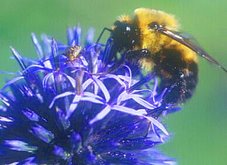
The Globe Thistle is very interesting if one likes thorny, prickly plants. The leaves are large, deeply cut and very prickly. The stems are silver-white, while the flowers are either white or a grayish metallic blue. The flower heads are round like a ball and are entirely covered with needle-like thistles All of the species bloom from June or July through September. Echinops Rilro has deep steel blue flowers and grows about 3 feet high E. sphaerocephalus is the tallest growing species, attaining a height of from 5 feet to 7 feet with large, white flowers. All the Globe Thistles are distinctive plants and are well adapted to plant in borders, among shrubbery or to use as bold specimen plants. The flower heads, which are excellent for cutting, can be dried and will remain attractive for months, They are also suitable for naturalizing in wild gardens.
Gloriosa Daisy
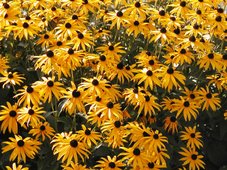
Rudbeckia hirta (common names :Black-eyed Susan, Blackiehead, Brown Betty, Brown Daisy, Brown-eyed Susan, Gloriosa Daisy, Golden Jerusalem, Poorland Daisy, Yellow Daisy, Yellow Ox-eye Daisy) is a flowering plant in the family Asteraceae. It is an upright annual (sometimes biennial or perennial) native to most of North America, and is one of a number of plants with the common name Black-eyed Susan that also has purple on the side. The plant can reach a height of 1-2 m. It has alternate, mostly basal leaves 20-75 cm long, covered by coarse hair. It flowers from June to August, with inflorescences measuring 10-15 cm in diameter (up to 30 cm in some cultivars), with yellow ray florets circling a brown, domed center of disc florets. Black-eyed Susan was designated the state Floral Emblem of Maryland in 1918.
Hen and Chicks

Hen and chicks is a common name for a group of small succulents belonging to the flowering plant family Crassulaceae, native to Europe and northern Africa. They grow close to the ground with leaves formed around each other in a rosette, and propagating by offsets. The 'hen' is the main plant, and the 'chicks' are the offspring, which start as tiny buds on the main plant and soon sprout their own roots, taking up residence close to the mother plant. Plants commonly referred to as "Hens and chicks" include ground hugging species of Sempervivum (Houseleeks) such as Sempervivum Pekinese, Sempervivum arachnoideum (Cobweb Houseleek), and Sempervivum tectorum (Common Houseleek); the related genus Jovibarba. The name is also used for some species of Echeveria, Sedum and Bergenia although these plants differ significantly from, and should not be confused with, Sempervivum and Jovibarba. The description below provides characteristics of Sempervivum and Jovibarba only. Aside from the common morphology, the many species of hen and chicks differ widely in appearance. Colours range from lime green to burgundy to purple, and size varies from as small as 1 cm to as large as 20 cm across. The leaves can be thin and spiky or thick and rounded with a pointed tip. Some, such as Cobweb Houseleek, have fine spiderweb-like filaments that grow naturally from leaf edge to leaf edge, forming a white cover on the top of the plant, while others have fine hairs that cover the entire plant structure. Upon maturity (usually around 3 to 4 years old) the plant will send up a single stalk that can reach 5-15 cm tall. The head of the stalk is a cluster of star-shaped flower buds 1-2 cm in diameter, which range in color from dark pink to yellow and that flower for several weeks. After blooming, the plant will die. Usually by this time it has produced many offsets ('chicks'). Hen and chicks are popular in gardens for their varied and interesting appearance and hardiness. They are grown as container planting or rock gardens. They do best in well-drained, rocky soil; if they stay wet, the outer leaves will rot. Although they do best in sun, they will grow in light shade.
Hollyhock

The hollyhocks comprise about 60 species of flowering plants in the genus Alcea (Ál-ce-a) in the mallow family Malvaceae, native to southwest and central Asia. They are biennial or short-lived perennial plants growing to 1-3 m tall, with broad, rounded, palmately lobed leaves and numerous flowers, pink or yellow in the wild species, on the erect central stem. Alcea species are used as food plants by the larvae of some Lepidoptera species including Bucculatrix quadrigemina and the Painted Lady (Vanessa cardui). Hollyhocks are popular garden ornamental plants, cultivars selected, particularly from A. rosea. The flowers have been selected for variations in colour, with dark purple, red and white-flowered plants available in addition to the colours found in wild plants. Hollyhocks are very drought resistant, and do well in full sun locations that might be too hot or dry for other plants. They produce large, flat coin-shaped seeds (1/2" diameter) that seem to grow easily wherever they drop. While an individual plant might only live a handful of years, by that time chances are good it will leave plenty of descendants. They have very long taproots which make transplanting difficult. A stylized, symmetrical hollyhock is the seal of the Tokugawa family in Japan, and is often used as a reference to the era in Japan's history where that family ruled the country.
Jacob's Ladder

Polemonium foliosissimum is easy to spot and identify because of its growth patterns: it is often in dense to loosely scattered colonies in open mountain meadows; it grows tall (commonly two to three feet) in an open, airy manner; and its leaves are finely cut. Its abundance of softly lavender/ blue/purple flowers are borne in numerous, showy clusters. Altogether, Polemonium foliosissimum is a softly appealing, lovely plant. Charles Parry first found this plant for science in Colorado and it was named by Asa Gray in 1878. "Foliosissimum" is Greek for "very leafy".
Lupin
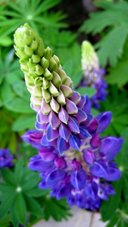
Lupin, often spelled lupine in North America, is the common name for members of the genus Lupinus in the family Fabaceae. The genus comprises between 150-200 species, and has a wide distribution in the Mediterranean region - Subgen. Lupinus, and the Americas - Subgen. Platycarpos (Wats.) Kurl. The species are mostly herbaceous perennial plants 0.3-1.5 m tall, but some are annual plants and a few are shrubs up to 3 m tall, with one, Lupinus jaimehintoniana, a tree 8 m high with a trunk 20 cm in diameter, from the Mexican state of Oaxaca. They have a characteristic and easily recognised leaf shape, with soft green to grey-green or silvery leaves with the blades usually palmately divided into 5–17 leaflets or reduced to a single leaflet in a few species of the southeastern United States; in many species, the leaves are hairy with silvery hairs, often densely so. The flowers are produced in dense or open whorls on an erect spike, each flower 1-2 cm long, with a typical peaflower shape with an upper 'standard', two lateral 'wings' and two lower petals fused as a 'keel'. The fruit is a pod containing several seeds. Like most members of this family, lupins can fix nitrogen from the atmosphere into ammonia, fertilizing the soil for other plants (see legume). The genus Lupinus is nodulated by the soil microorganism Bradyrhizobium sp. (Lupinus). Some species have a long central tap root. The yellow legume seeds of Lupins, commonly called Lupini beans, were quite popular with the Romans and they spread the cultivation of them throughout the Roman Empire. Today, Lupini are most commonly found in Mediterranean countries, especially in Portugal, Egypt, and Italy, and also in Brazil & In Spanish Harlem, where it is popular along with beer. In Portuguese the Lupini Beans are known as "tremoços". In Antalya, Turkey it is known as Tirmis amongst the local people. The Andean American variety of this bean is the Lupinus mutabilis, a widespread food during the Incan Empire. They are commonly sold in a salty solution in jars (like olives and pickles) and can be eaten with or without the skin. Lupins are popular ornamental plants in gardens. There are numerous hybrids and cultivars. Some species, such as Lupinus polyphyllus and hybrids like the Rainbow Lupin (Lupinus × regalis) are common garden flowers. Others, such as the Yellow Bush Lupin L. arboreus are considered invasive weeds when they appear outside their native range. Lupins are also cultivated as forage and grain legumes. Three Mediterranean species of lupin, Lupinus angustifolius (Blue Lupin), Lupinus albus (White Lupin) and Lupinus luteus (Yellow Lupin) are cultivated for livestock and poultry feed and for human consumption. The Andean Lupin Lupinus mutabilis and the Mediterranean L. albus, L. angustifolius[2] and L. hirsutus[3](these varieties are known locally as altramuz in Spain and Argentina) are also edible after soaking the seeds for some days in salted water [4]. These lupins are referred to as sweet lupins because they contain smaller amounts of toxic alkaloids than the bitter varieties. Both sweet and bitter lupins in feed can cause livestock poisoning. Lupin poisoning is a nervous syndrome caused by alkaloids in bitter lupins, similar to Neurolathyrism. Mycotoxic lupinosis is a disease caused by lupin material that is infected with the fungus Diaporthe toxica; the fungus produces mycotoxins called phomopsins, which cause liver damage. The worst damage to lupin is caused by anthracnose, fusarium wilt, fusarium and other root rot, bacteria and viruses.
Mrs. Bradshaw

Geum (Avens) is a genus of about 50 species of perennial herbaceous plants in the rose family Rosaceae, native to Europe, Asia, North and South America, Africa and New Zealand. They are closely related to Potentilla and Fragaria. The Geum 'Mrs. Bradshaw‘, Geum chiloense, produces lovely scarlet, semi-double flowers that are shaped like small roses. Its fresh green, fuzzy foliage makes it different from the rest. With a plant height of 3’ and a spread of 12-18”, this is a highly valued plant. ‘Mrs. Bradshaw’ has a long blooming season, from May to July, and is easy to care for. Not bothered by pest or insects, it is one to defiantly try. ‘Mrs. Bradshaw’ needs full sun but can tolerate afternoon shade, in moist well-drained soil. It is a perfect addition to any cottage garden, makes a wonderful combination with bright yellows, gold’s and true blues (like Delphiniums, Salvias), for borders and mass plantings and for cuttings.
Mugho Pine (It's Moo Goo!!! Our First Garden Purchase!!)

The Mugho Pine tree, Pinus mugo mughus, may also be called the dwarf mountain pine. This evergreen little dwarf conifer has branching, upright stems evenly covered in 2-inch-long needles of a deep, dark true green. Thanks to its low growth, mugho pine can be used at the front of a border or anywhere you want year-round greenery in conifer form. Mugho pine trees do not need special soil. In nature, it often grows in slightly rocky areas with shallow topsoil. It does require good drainage. Roots grow near the surface, so using a cover soil with a 2-inch-thick mulch to protect them is recommended. These trees are easily transplanted. They make a great landscaping evergreen tree because their shape and size are controllable by shearing.
Poppy

Poppies need to be planted in full sun, in a moist but well drained area. It has a plant height and width of 24" and blooms from May until July. Poppies are best used as cut flowers, as a border plant and as underplantings to larger, late flowering perennials. They do go dormant in July or August, and the foliage will die back completely to the ground. Avoid planting in wide open spaces.
Rhododendron

Rhododendron (from the Greek: rhodos, "rose", and dendron, "tree") is a genus of flowering plants in the family Ericaceae. It is a large genus with over 1000 species and most have showy flower displays. It includes the plants known to gardeners as azaleas. The Rhododendron is an interesting genus characterized by shrubs and small to (rarely) large trees, the smallest species growing to 10-20 cm tall, and the largest, R. arboreum, reported to 50 m tall. The leaves are spirally arranged; leaf size can range from 1-2 cm to over 50 cm, exceptionally 100 cm in R. sinogrande. They may be either evergreen or deciduous. In some species the underside of the leaves are covered with scales (lepidote) or hairs (indumentum). Some of the best known species are noted for their many clusters of large flowers. There are alpine species with small flowers and small leaves, and tropical species such as subgenus Vireya that often grow as epiphytes. Rhododendron is a very widely distributed genus, occurring throughout most of the Northern Hemisphere except for dry areas, and extending into the Southern Hemisphere in southeastern Asia and northern Australasia. The highest species diversity is found in the Sino-Himalayan mountains from central Nepal and Sikkim east to Yunnan and Sichuan, with other significant areas of diversity in the mountains of Indo-China, Korea, Japan and Taiwan. In addition, there are a significant number of tropical rhododendron species from southeast Asia to northern Australia, with 55 known species in Borneo and 164 in New Guinea [1]. Relatively fewer species occur in North America and Europe. Rhododendrons have not been found in South America or Africa. Rhododendrons are extensively hybridized in cultivation, and natural hybrids often occur in areas where species ranges overlap. There are over 28,000 cultivars of Rhododendron in the International Rhododendron Registry held by the Royal Horticultural Society. Most have been bred for their flowers, but a few are of garden interest because of ornamental leaves and some for ornamental bark or stems. Both species and hybrid rhododendrons (including azaleas) are used extensively as ornamental plants in landscaping in many parts of the world, and many species and cultivars are grown commercially for the nursery trade. Rhododendrons are often valued in landscaping for their structure, size, flowers, and the fact that many of them are evergreen [5]. Azaleas are frequently used around foundations and occasionally as hedges, and many larger-leafed rhododendrons lend themselves well to more informal plantings and woodland gardens, or as specimen plants. In some areas, larger rhododendrons can be pruned to encourage more tree-like form, with some species such as R. arboreum and R. falconeri eventually growing to 10-15 m or more tall. Like other ericaceous plants, most rhododendrons prefer acid soils with a pH of roughly 4.5-5.5; some tropical Vireyas and a few other rhododendron species grow as epiphytes and require a planting mix similar to orchids. Rhododendrons have fibrous roots and prefer well-drained soils high in organic material. In areas with poorly-drained or alkaline soils, rhododendrons are often grown in raised beds using mediums such as composted pine bark.[7]. Mulching and careful watering are important, especially before the plant is established.
Summer Skies
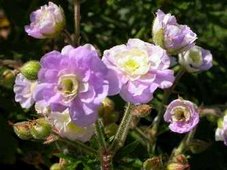
SUMMER SKIES is noted for its double flowers. It is a mounding, clump-forming perennial that typically grows to 24” tall and spreads to 24” wide. Features soft, violet-blue double flowers (to 1.25” diameter) with fine dark veining and a hint of greenish-white in the center. Flowers typically bloom from late spring to early summer in hot summer climates such as St. Louis, but may bloom throughout the summer into fall in cooler northern climates. Sparse late summer and/or fall rebloom may occur in St. Louis if plants are cut back hard after flowering. Deeply cut gray-green foliage. Easily grown in average, medium wet, well-drained soil in full sun to part shade. Prefers moist, organic soils. Also prefers part afternoon shade in hot summer climates such as the St. Louis area. Plants may be cut or sheared back after flowering to rejuvenate, shape and/or encourage rebloom. Side stems may be removed or trimmed at any time to control spread. No serious insect or disease problems. Taller stems may need some support. Specimen, group or mass in borders, rock gardens or cottage gardens.
Sweet Million (We GOTTA Have Some Cherry Tomatoes in Our Garden!!)

Early maturing hybrid cherry type tomato. Clusters of tiny fruit are well rounded, deep red in color with a delicious sweet flavor. Tolerance to cracking and good holding qualities. Tall Indeterminate plants grow tall and require support. Maturity is 60 days from transplanting.

